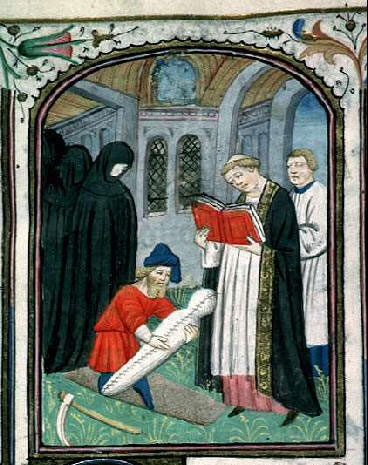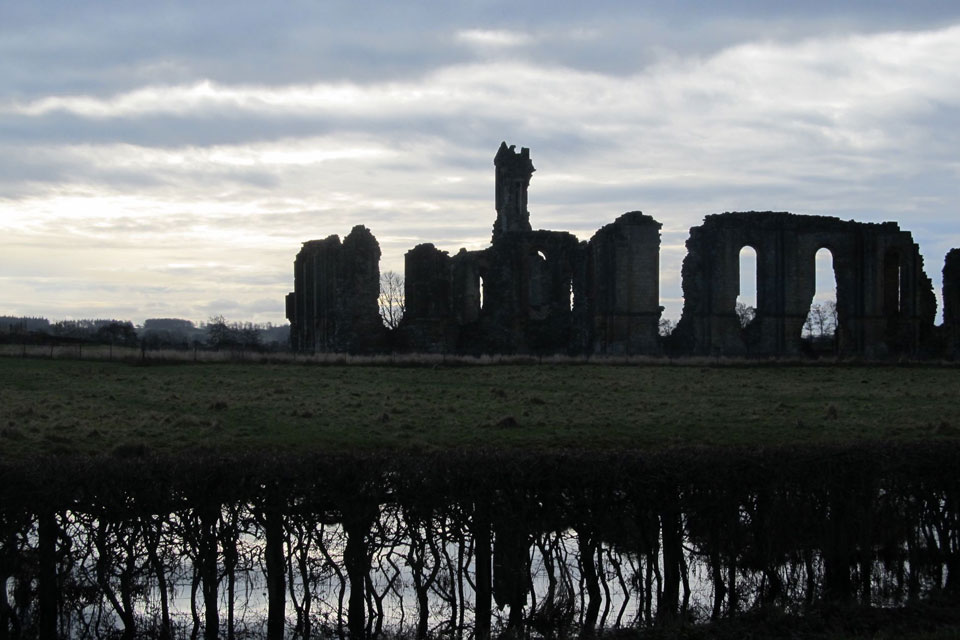This year, no guising and souling. Most children will be kept at home. So how to keep the poor sweet things occupied? Try telling them medieval ghost stories!
Today, Byland Abbey is but a ruined place located in a flat and rather swampy landscape of sour grassland. Lying at the foot of a low undulating ridge with cliffs and moors to the east and north it was once upon a time the mightiest Cistercian monastery in the north located in the middle of a watery and unapproachable landscape, which the monks sought to control by draining and channelling. At its zenith, at least 80 monks and 160 lay brethren lived in the shade of the towering church. In the later middle ages, it was also fitted out by a grandiose free-standing lodging reserved for the abbot and a 100-acre deer park which was created in 1380.
One day, a monk sat down in the scriptorium to record twelve ghost stories on a blank page at the end of an otherwise ordinary manuscript of rhetorical and theological works, British Library Royal MS 15 A XX. Apart from the rich Icelandic material, the Byland stories are part of one of the best-preserved collections from the middle ages. Curiously enough, some of the stories are reminiscent of later folkloristic collections from Scandinavia.
Medieval Apparitions

At first, the church was profoundly suspicious of the ghostly apparitions which permeated the world of Late Antiquity. At the end of the first millennium, purgatory was officially recognised as a separate realm where afterlife was spent until the final reckoning. This stay was more or less pleasant according to the sins committed while living. However, relatives might propitiate the suffering by helping out with masses, gifts and other acts of intervention (prayers). In the later Middle Ages, these ideas led to the formation of the well-organised market for indulgencies, which was one of the main instigators of the Lutheran Reformation.
To help out, however, family and relatives had to know of the misery of the poor souls kept in purgatory. This led to the idea that some souls were active as spirits in the world of the living – warning their relatives or begging for suffrages. Occasionally, they also played the role of heralds, warning of future horrors or miseries to come.
Such spirits were neither pure bodies, nor pure souls. They might shift-shape between being animals or human-like spectres. Or they may be partly rotting, if touched. Apparently, they were afraid of water, which might dismember them totally.
The Byland Ghosts
The ghost stories from Byland are rendered in a short form and in Latin. In no way do they present themselves as waxing lyrical horror-stories intended to strike horror into the hearts of the listeners. Rather, they read as memory aids to any priest, who might be asked to entertain monks at dinner on all Souls. In order to tell them to your grandchildren, you have to learn them by heart and then fill out the spaces with darkness, scary waters and strange creatures.
Also, the form of the stories follows a distinct formula, where a living and dead person meet, and the living person seeks to deflect the dead by appealing to Christ, do the sign of the cross, or appeal to the Trinity. Next phase consists of the conjuring whereby the living gets to know the name of the dead and his misdemeanours, which the living person then tries to remedy. At this point, they typically enter the “marketplace” to obtain absolution and peace.
READ THE STORIES HERE:
SOURCES:
Royal MS. 15, A. XX. British Royal Library
Twelve Medieval Ghost-Stories
Transcribed and edited by M. R. James in Latin
In: The English Historical Review, Vol. 37, No. 147 (Jul., 1922), pp. 413-422
Twelve Medieval Ghost Stories
By A. J. Grant
In: Yorkshire Archaeological Journal (1924), Vol. 27
pp. 362-379
Medieval Ghosts: the Stories of the Monk of Byland
By Maik Hildebrandt
In: Ghosts – or the (Nearly) Invisible Spectral Phenomena in Literature and the Media.
Edited By Maria Fleischhack and Elmar Schenkel
Series: ALPH: Arbeiten zur Literarischen Phantastik / ALPH: Approaches to Literary Phantasy
Frankfurt am Main, Berlin, Bern, Bruxelles, New York, Oxford, Wien, Peter Lang 2016
READ MORE:
READ ALSO:




